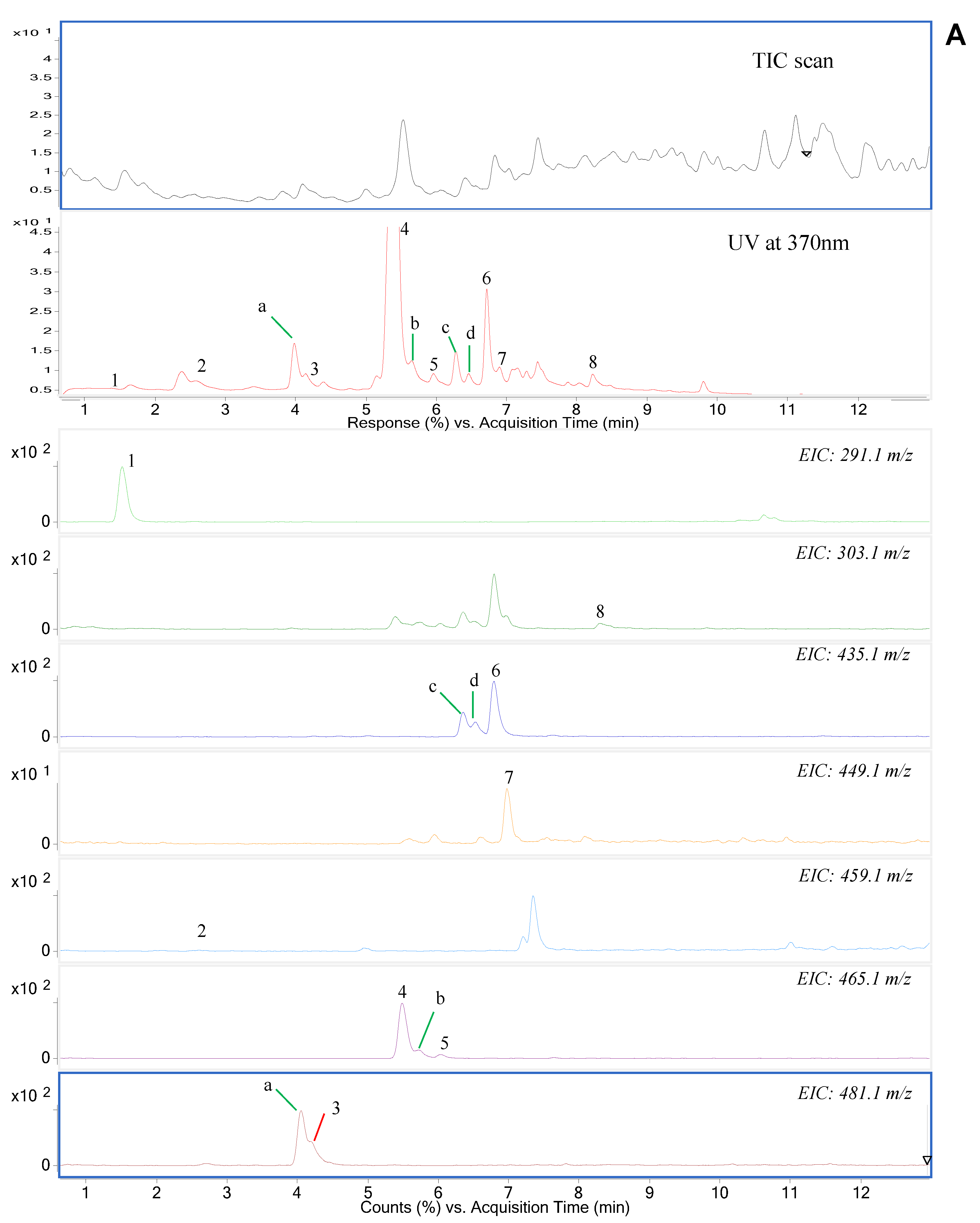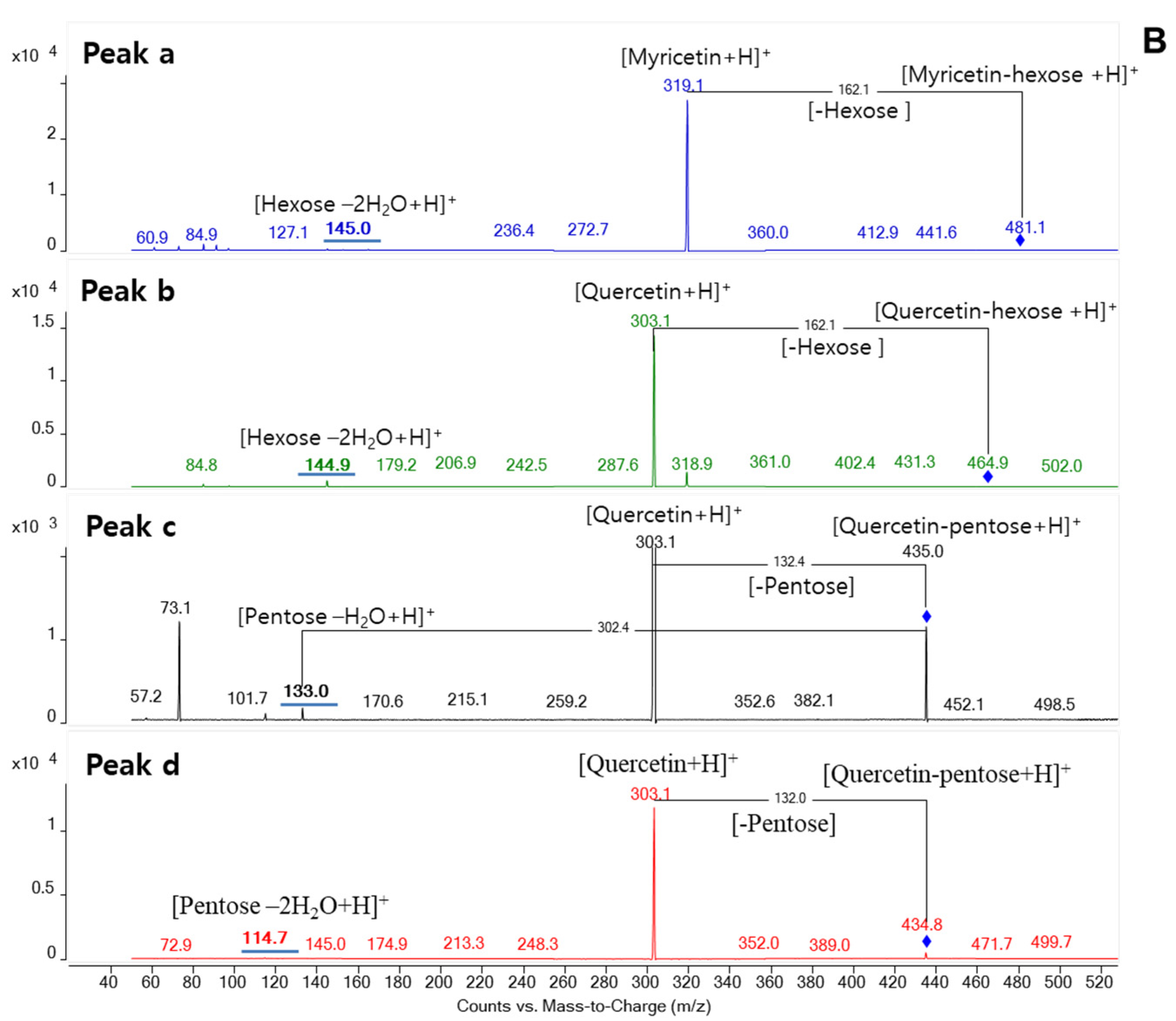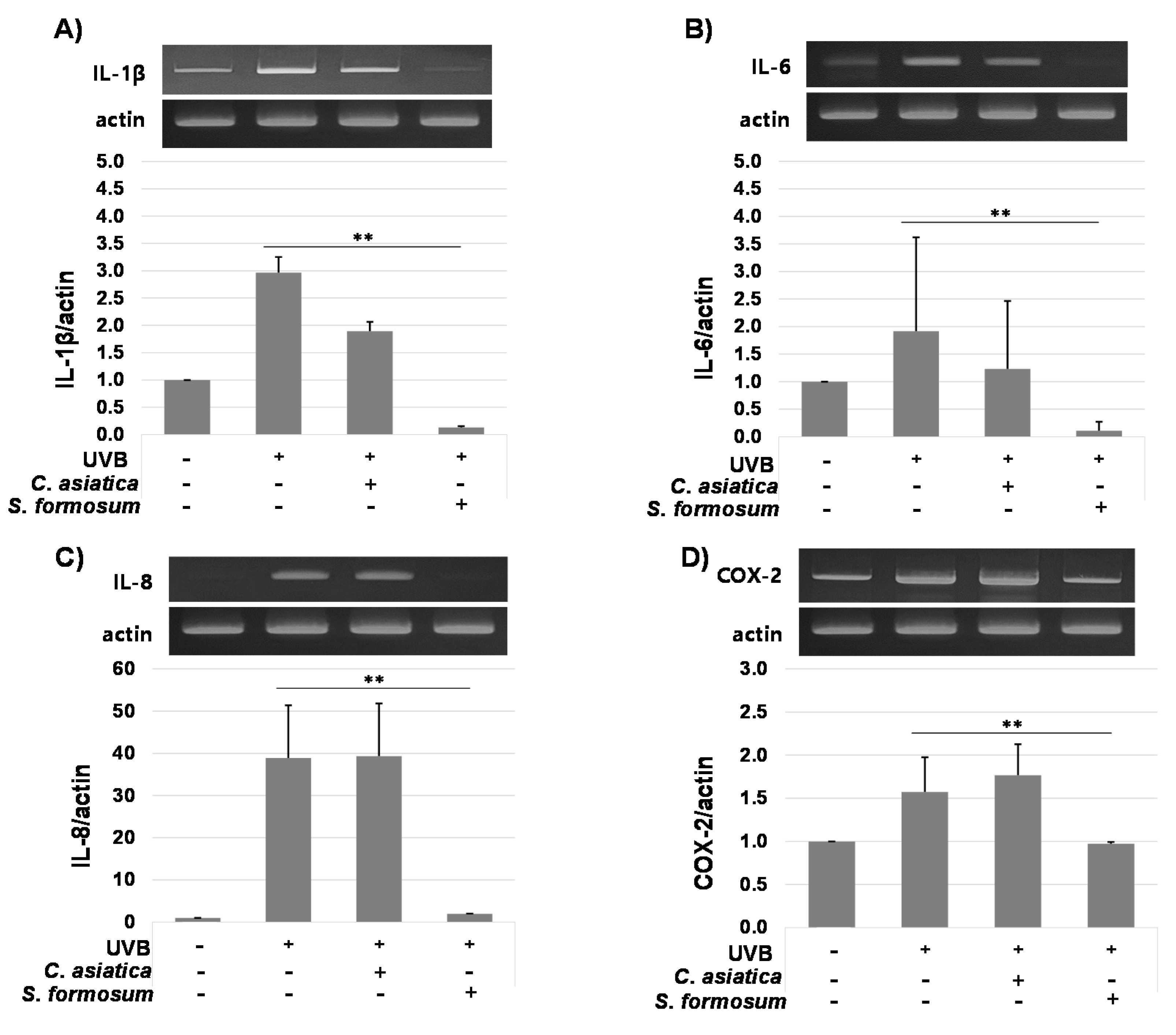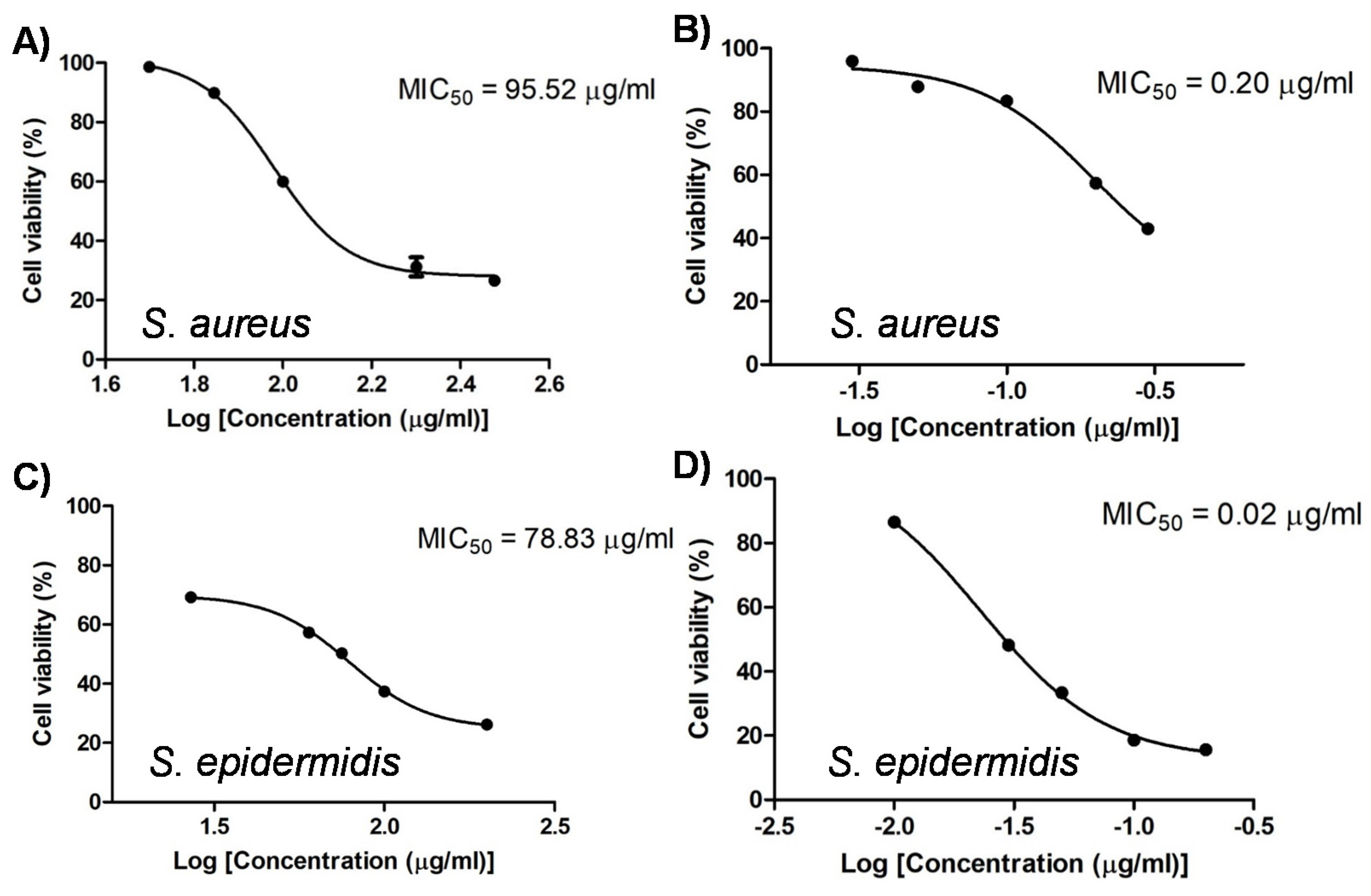Comparative Phytochemical Analysis of Syzygium formosum (Wall.) Masam Leaf and Its Biological Activities
Abstract
:Featured Application
Abstract
1. Introduction
2. Materials and Methods
2.1. Chemicals
Preparation of Standard Solutions
2.2. Plant Materials
2.3. Sample Purification
2.4. LC-MS/MS Analysis
2.5. Method Validation
2.6. Anti-Inflammation Assay Using HaCaT Cells
2.7. Antibacterial Effect of Syzygium formosum Leaves
2.7.1. Antibacterial Assay on Staphylococcus Species
2.7.2. Antibacterial Assay on Cutibacterium acnes
2.8. Data Analysis
3. Results
3.1. Phytochemical Profiling of Syzygium formosum Leaves Using LC-MS/MS
3.2. Method Validation
3.3. Phytochemical Composition in Syzygium formosum Leaves
3.3.1. Flavonoids
3.3.2. Phenolic Acids
3.3.3. Triterpenoids
3.4. Comparison of Triterpenoids between Syzygium formosum and Centella asiatica Leaves
3.5. Anti-Inflammatory Effects of Syzygium formosum
3.6. Antibacterial Effect of Syzygium formosum Extract
4. Discussion
5. Conclusions
Supplementary Materials
Author Contributions
Funding
Institutional Review Board Statement
Informed Consent Statement
Data Availability Statement
Conflicts of Interest
References
- Soh, W.-K.; Parnell, J. A revision of Syzygium Gaertn (Myrtaceae) in Indochina (Cambodia, Laos and Vietnam). Adansonia 2015, 37, 179–275. [Google Scholar]
- Do, T. Medicinal Plants and Remedies of Vietnam; Medicine Publishing House: Hanoi, Vietnam, 2001; 826p. [Google Scholar]
- Parul, R.; Das, A.K.; Rana, M.S. Comparative pharmacological evaluation in respect to non-polar and polar solvent extracts of the leaves of Syzygium balsameum & Syzygium formosum. J. Pharmacogn. Phytochem. 2020, 9, 45–52. [Google Scholar]
- Nong, T. Research on Phytochemical Constituents of Syzygium Formosum in Thai Nguyen-Vietnam; Chemistry Department, Thai Nguyen University: Taiyuan, China, 2009. [Google Scholar]
- Thuong, P.T.; Na, M.-K.; Dang, N.H.; Hung, T.M.; Ky, P.T.; Thanh, T.V.; Nam, N.H.; Thuan, N.D.; Sok, D.-E.; Bae, K.-H. Antioxidant activities of Vietnamese medicinal plants. Nat. Prod. Sci. 2006, 12, 29–37. [Google Scholar]
- Nguyen, T.M.N.; Lomunova, M.; Vu, T.P.D.; Le, B.V.; Kim, Y.H.; Kang, J.S.; Hwang, I. Anti-allergic effects of the ethanol extract of Syzygium formosum (Wall.) Masam leaves and its immunoregulatory mechanisms. J. Ethnopharmacol. 2018, 211, 171–179. [Google Scholar] [CrossRef]
- Zhang, J.; Yamada, S.; Ogihara, E.; Kurita, M.; Banno, N.; Qu, W.; Feng, F.; Akihisa, T. Biological activities of triterpenoids and phenolic compounds from Myrica cerifera bark. Chem. Biodivers. 2016, 13, 1601–1609. [Google Scholar] [CrossRef] [PubMed]
- Nzogong, R.T.; Ndjateu, F.S.T.; Ekom, S.E.; Fosso, J.-A.M.; Awouafack, M.D.; Tene, M.; Tane, P.; Morita, H.; Choudhary, M.I.; Tamokou, J.-d.-D. Antimicrobial and antioxidant activities of triterpenoid and phenolic derivatives from two Cameroonian Melastomataceae plants: Dissotis senegambiensis and Amphiblemma monticola. BMC Complementary Altern. Med. 2018, 18, 159. [Google Scholar] [CrossRef]
- Manosroi, A.; Jantrawut, P.; Ogihara, E.; Yamamoto, A.; Fukatsu, M.; Yasukawa, K.; Tokuda, H.; Suzuki, N.; Manosroi, J.; Akihisa, T. Biological activities of phenolic compounds and triterpenoids from the galls of Terminalia chebula. Chem. Biodivers. 2013, 10, 1448–1463. [Google Scholar] [CrossRef]
- Vu, T.P.D.; Khong, T.Q.; Nguyen, T.M.N.; Kim, Y.H.; Kang, J.S. Phytochemical profile of Syzygium formosum (Wall.) Masam leaves using HPLC–PDA–MS/MS and a simple HPLC–ELSD method for quality control. J. Pharm. Biomed. Anal. 2019, 168, 1–12. [Google Scholar]
- Dzubak, P.; Hajduch, M.; Vydra, D.; Hustova, A.; Kvasnica, M.; Biedermann, D.; Markova, L.; Urban, M.; Sarek, J. Pharmacological activities of natural triterpenoids and their therapeutic implications. Nat. Prod. Rep. 2006, 23, 394–411. [Google Scholar] [CrossRef]
- Shu, Z.; Pu, J.; Chen, L.; Zhang, Y.; Rahman, K.; Qin, L.; Zheng, C. Alisma orientale: Ethnopharmacology, phytochemistry and pharmacology of an important traditional Chinese medicine. Am. J. Chin. Med. 2016, 44, 227–251. [Google Scholar] [CrossRef]
- Thakurdesai, P.A. Centella asiatica (Gotu kola) leaves: Potential in neuropsychiatric conditions. In Nutraceuticals in Brain Health and Beyond; Elsevier: Cham, Switzerland, 2021; pp. 307–328. [Google Scholar]
- Ho, P.J.; Sung, J.J.; Cheon, K.K.; Tae, H.J. Anti-inflammatory effect of Centella asiatica phytosome in a mouse model of phthalic anhydride-induced atopic dermatitis. Phytomedicine 2018, 43, 110–119. [Google Scholar]
- Brinkhaus, B.; Lindner, M.; Schuppan, D.; Hahn, E. Chemical, pharmacological and clinical profile of the East Asian medical plant Centella aslatica. Phytomedicine 2000, 7, 427–448. [Google Scholar] [CrossRef]
- Sun, B.; Wu, L.; Wu, Y.; Zhang, C.; Qin, L.; Hayashi, M.; Kudo, M.; Gao, M.; Liu, T. Therapeutic potential of Centella asiatica and its triterpenes: A review. Front. Pharmacol. 2020, 11, 1373. [Google Scholar] [CrossRef]
- Roy, A.; Krishnan, L.; Bharadvaja, N. Qualitative and quantitative phytochemical analysis of Centella asiatica. Nat. Prod. Chem. Res. 2018, 6, 4. [Google Scholar] [CrossRef]
- Shen, X.; Guo, M.; Yu, H.; Liu, D.; Lu, Z.; Lu, Y. Propionibacterium acnes related anti-inflammation and skin hydration activities of madecassoside, a pentacyclic triterpene saponin from Centella asiatica. Biosci. Biotechnol. Biochem. 2019, 83, 561–568. [Google Scholar] [CrossRef]
- Sawatdee, S.; Choochuay, K.; Chanthorn, W.; Srichana, T. Evaluation of the topical spray containing Centella asiatica extract and efficacy on excision wounds in rats. Acta Pharm. 2016, 66, 233–244. [Google Scholar] [CrossRef] [PubMed] [Green Version]
- Seo, S.; Kim, Y. Improving cosmetic activity by optimizing Centella asiatica extraction process. Nat. Prod. Commun. 2019, 14, 1934578X19867188. [Google Scholar] [CrossRef] [Green Version]
- Ratz-Łyko, A.; Arct, J.; Pytkowska, K. Moisturizing and antiinflammatory properties of cosmetic formulations containing Centella asiatica extract. Indian J. Pharm. Sci. 2016, 78, 27. [Google Scholar] [CrossRef] [Green Version]
- Yadav, M.; Chatterji, S.; Gupta, S.K.; Watal, G. Preliminary phytochemical screening of six medicinal plants used in traditional medicine. Int. J. Pharm. Pharm. Sci. 2014, 6, 539–542. [Google Scholar]
- Nahar, L.; Sarker, S.D. Chemistry for Pharmacy Students: General, Organic and Natural Product Chemistry; John Wiley & Sons: Hoboken, NJ, USA, 2019. [Google Scholar]
- Ahmad, S.; Ullah, F.; Ayaz, M.; Sadiq, A.; Imran, M. Antioxidant and anticholinesterase investigations of Rumex hastatus D. Don: Potential effectiveness in oxidative stress and neurological disorders. Biol. Res. 2015, 48, 20. [Google Scholar] [CrossRef] [PubMed] [Green Version]
- Loc, N.H.; An, N.T.T. Asiaticoside production from centella (Centella asiatica L. Urban) cell culture. Biotechnol. Bioprocess Eng. 2010, 15, 1065–1070. [Google Scholar] [CrossRef]
- Šiman, P.; Filipová, A.; Tichá, A.; Niang, M.; Bezrouk, A.; Havelek, R. Effective method of purification of betulin from birch bark: The importance of its purity for scientific and medicinal use. PLoS ONE 2016, 11, e0154933. [Google Scholar] [CrossRef] [Green Version]
- Rastogi, S.; Pandey, M.M.; Rawat, A.K.S. Medicinal plants of the genus Betula—Traditional uses and a phytochemical–pharmacological review. J. Ethnopharmacol. 2015, 159, 62–83. [Google Scholar] [CrossRef] [PubMed]
- Kim, Y.-J.; Zhang, D.; Yang, D.-C. Biosynthesis and biotechnological production of ginsenosides. Biotechnol. Adv. 2015, 33, 717–735. [Google Scholar] [CrossRef]
- Lee, W.; Kim, J.; Park, E.K.; Bae, J.-S. Maslinic acid ameliorates inflammation via the downregulation of NF-κB and STAT-1. Antioxidants 2020, 9, 106. [Google Scholar] [CrossRef] [Green Version]
- Juan, M.E.; Planas, J.M. Cancer chemopreventive activity of maslinic acid, a pentacyclic triterpene from olives and olive oil. In Olives and Olive Oil in Health and Disease Prevention; Elsevier: Cham, Switzerland, 2021; pp. 525–535. [Google Scholar]
- Lee, S.Y.; Kim, Y.J.; Chung, S.O.; Park, S.U. Recent studies on ursolic acid and its biological and pharmacological activity. EXCLI J. 2016, 15, 221. [Google Scholar] [PubMed]
- Nguyen, H.N.; Ullevig, S.L.; Short, J.D.; Wang, L.; Ahn, Y.J.; Asmis, R. Ursolic Acid and Related Analogues: Triterpenoids with Broad Health Benefits. Antioxidants 2021, 10, 1161. [Google Scholar] [CrossRef]
- Yamada, K.; Hosokawa, M.; Fujimoto, S.; Fujiwara, H.; Fujita, Y.; Harada, N.; Yamada, C.; Fukushima, M.; Ueda, N.; Kaneko, T. Effect of corosolic acid on gluconeogenesis in rat liver. Diabetes Res. Clin. Pract. 2008, 80, 48–55. [Google Scholar] [CrossRef]
- Shi, L.; Zhang, W.; Zhou, Y.-Y.; Zhang, Y.-N.; Li, J.-Y.; Hu, L.-H.; Li, J. Corosolic acid stimulates glucose uptake via enhancing insulin receptor phosphorylation. Eur. J. Pharmacol. 2008, 584, 21–29. [Google Scholar] [CrossRef]
- Weber, L.A.; Meißner, J.; Delarocque, J.; Kalbitz, J.; Feige, K.; Kietzmann, M.; Michaelis, A.; Paschke, R.; Michael, J.; Pratscher, B. Betulinic acid shows anticancer activity against equine melanoma cells and permeates isolated equine skin in vitro. BMC Vet. Res. 2020, 16, 44. [Google Scholar] [CrossRef]
- Liu, C.; Chen, Y.; Lu, C.; Chen, H.; Deng, J.; Yan, Y.; Xu, Y.-Y.; Liu, H.; Huang, H.; Wei, J. Betulinic acid suppresses Th17 response and ameliorates psoriasis-like murine skin inflammation. Int. Immunopharmacol. 2019, 73, 343–352. [Google Scholar] [CrossRef]
- Hudlikar, R.R.; Sargsyan, D.; Wu, R.; Su, S.; Zheng, M.; Kong, A.-N. Triterpenoid corosolic acid modulates global CpG methylation and transcriptome of tumor promotor TPA induced mouse epidermal JB6 P+ cells. Chem. Biol. Interact. 2020, 321, 109025. [Google Scholar] [CrossRef]
- Domitrović, R.; Rashed, K.; Cvijanović, O.; Vladimir-Knežević, S.; Škoda, M.; Višnić, A. Myricitrin exhibits antioxidant, anti-inflammatory and antifibrotic activity in carbon tetrachloride-intoxicated mice. Chem. Biol. Interact. 2015, 230, 21–29. [Google Scholar] [CrossRef]
- Katiyar, S.K.; Ahmad, N.; Mukhtar, H. Green tea and skin. Arch. Dermatol. 2000, 136, 989–994. [Google Scholar] [CrossRef] [PubMed]
- Bae, J.; Kim, N.; Shin, Y.; Kim, S.-Y.; Kim, Y.-J. Activity of catechins and their applications. Biomed. Dermatol. 2020, 4, 8. [Google Scholar] [CrossRef] [Green Version]
- Khan, B.A.; Mahmood, T.; Menaa, F.; Shahzad, Y.; Yousaf, A.M.; Hussain, T.; Ray, S.D. New perspectives on the efficacy of gallic acid in cosmetics & nanocosmeceuticals. Curr. Pharm. Des. 2018, 24, 5181–5187. [Google Scholar]
- Yang, D.J.; Moh, S.H.; Son, D.H.; You, S.; Kinyua, A.W.; Ko, C.M.; Song, M.; Yeo, J.; Choi, Y.-H.; Kim, K.W. Gallic acid promotes wound healing in normal and hyperglucidic conditions. Molecules 2016, 21, 899. [Google Scholar] [CrossRef] [PubMed] [Green Version]
- Vitonyte, J.; Manca, M.L.; Caddeo, C.; Valenti, D.; Peris, J.E.; Usach, I.; Nacher, A.; Matos, M.; Gutiérrez, G.; Orrù, G. Bifunctional viscous nanovesicles co-loaded with resveratrol and gallic acid for skin protection against microbial and oxidative injuries. Eur. J. Pharm. Biopharm. 2017, 114, 278–287. [Google Scholar] [CrossRef] [PubMed]
- Tsang, M.S.; Jiao, D.; Chan, B.C.; Hon, K.-L.; Leung, P.C.; Lau, C.; Wong, E.C.; Cheng, L.; Chan, C.K.; Lam, C.W. Anti-inflammatory activities of pentaherbs formula, berberine, gallic acid and chlorogenic acid in atopic dermatitis-like skin inflammation. Molecules 2016, 21, 519. [Google Scholar] [CrossRef] [Green Version]




| No | Gene | Forward | Reverse |
|---|---|---|---|
| 1 | Actin | GGC GGA CTA TGA CTT AGT TG | AAC AAC AAT GTG CAA TCA A |
| 2 | IL-1β | GGG CCT CAA GGA AAA GAA TC | TTC TGC TTG AGA GGT GCT GA |
| 3 | IL-6 | AGG AGA CTT GCC TGG TGA AA | CAG GGG TGG TTA TTG CAT CT |
| 4 | IL-8 | TCT GTG TGA AGG TGC ACT T | AGC CCT CTT CAA AAA CTT CT |
| 5 | COX-2 | GGT CTG GTG CCT GGT CTG ATG | GTC CTT TCA AGG AGA ATG GTG C |
| Groups | Compounds | Molecular Formula | Retention Time (min) | Precursor Ion (m/z) | Product Ions (m/z) |
|---|---|---|---|---|---|
| Flavonoids | Catechin | C15H14O6 | 1.52 | 291.1 [M+H]+ | 139, 123 |
| EGCG | C22H18O11 | 2.46 | 459.0 [M+H]+ | 139, 289 | |
| Myricetin glucoside | C21H20O13 | 4.06 | 481.1 [M+H]+ | 319, 145 | |
| Myricetin rhamnoside | C21H20O12 | 5.49 | 465.1 [M+H]+ | 319, 129 | |
| Quercetin glucoside | C21H20O12 | 6.02 | 465.1 [M+H]+ | 303, 145 | |
| Quercetin arabinoside | C20H18O11 | 6.79 | 435.1 [M+H]+ | 303, 133 | |
| Quercetin rhamnoside | C21H20O11 | 6.97 | 449.0 [M+H]+ | 303, 129 | |
| Quercetin | C15H10O7 | 8.30 | 303.1 [M+H]+ | 153, 137 | |
| Phenolic acids | Gallic acid | C7H6O5 | 1.15 | 168.9 [M−H]− | 125, 79 |
| 3,4-DHBA | C7H6O4 | 1.77 | 153.0 [M−H]− | 109, 91 | |
| p-coumaric acid | C9H8O3 | 5.57 | 162.9 [M−H]− | 119, 93 | |
| Triterpenoids | Madecassic acid | C30H48O6 | 3.68 | 469.3 [M−2H2O+H]+ | 189.1, 235.1 |
| Asiatic acid | C30H48O5 | 4.61 | 453.3 [M-2H2O+H]+ | 187.1, 203.1 | |
| Hederagenin | C30H48O4 | 7.08 | 455.3 [M−H2O+H]+ | 177.1, 189.1 | |
| Maslinic acid | 8.53 | 455.3 [M−H2O+H]+ | 189.1, 203.1 | ||
| Corosolic acid | 8.93 | 455.3 [M−H2O+H]+ | 189.1, 205.1 | ||
| Betulin | C30H50O2 | 11.71 | 425.3 [M−H2O+H]+ | 191.1, 217.1 | |
| Betulinic acid | C30H48O3 | 12.66 | 439.3 [M−H2O+H]+ | 137.1, 191.1 | |
| Oleanolic acid | 13.67 | 439.3 [M−H2O+H]+ | 191.1, 203.1 | ||
| Ursolic acid | 13.98 | 439.3 [M−H2O+H]+ | 191.1, 203.1 |
| Group | Analytes | Sampling Area | |
|---|---|---|---|
| Phu Tho | Ha Noi | ||
| Flavonoids | Catechin | 1.09 ± 0.13 a | 0.41 ± 0.08 b |
| EGCG | 0.03 ± 0.00 a | 0.02 ± 0.00 a | |
| Myricetin glucoside | 0.04 ± 0.00 b | 0.07 ± 0.01 a | |
| Myricetin rhamnoside | 0.52 ± 0.00 b | 1.47 ± 0.17 a | |
| Quercetin glucoside | 0.02 ± 0.00 b | 0.06 ± 0.00 a | |
| Quercetin arabinoside | 0.11 ± 0.02 b | 0.56 ± 0.05 a | |
| Quercetin rhamnoside | 0.02 ± 0.00 b | 0.06 ± 0.00 a | |
| Quercetin | 0.02 ± 0.00 b | 0.07 ± 0.01 a | |
| Total | 1.85 ± 0.11 b | 2.72 ± 0.24 a | |
| Phenolic acids | Gallic acid | 0.85 ± 0.09 a | 0.78 ± 0.15 a |
| 3,4-DHBA | 0.04 ± 0.00 a | 0.03 ± 0.01 a | |
| p-Coumaric acid | 0.01 ± 0.00 a | 0.01 ± 0.00 a | |
| Total | 0.89 ± 0.40 a | 0.81 ± 0.71 a | |
| Triterpenoids | Syzygium formosum | Centella asiatica | ||
|---|---|---|---|---|
| Phu Tho | Ha Noi | Indonesia | Korea | |
| Madecassic acid | 0.24 ± 0.02 c | 0.41 ± 0.01 b | 2.02 ± 0.03 a | 0.53 ± 0.11 b |
| Asiatic acid | 2.78 ± 0.23 c | 8.59 ± 0.48 a | 3.83 ± 0.41 b | 0.81 ± 0.10 d |
| Hederagenin | 0.02 ± 0.00 b | 0.05 ± 0.00 a | ND | ND |
| Maslinic acid | 0.89 ± 0.08 b | 1.26 ± 0.08 a | ND | ND |
| Corosolic acid | 3.19 ± 0.18 b | 3.91 ± 0.45 a | ND | ND |
| Betulin | 0.11 ± 0.00 b | 0.15 ± 0.02 a | ND | ND |
| Betulinic acid | 6.14 ± 0.49 a | 3.58 ± 0.23 b | ND | ND |
| Oleanolic acid | 0.19 ± 0.04 b | 0.27 ± 0.02 a | ND | ND |
| Ursolic acid | 0.62± 0.11 b | 0.78 ± 0.15 a | ND | ND |
| Total | 14.18 ± 1.15 b | 19.00 ± 1.51 a | 5.85 ± 0.44 c | 1.34 ± 0.21 d |
| Dilution | 103 | 104 | 105 | 106 | CFU/mL | |
|---|---|---|---|---|---|---|
| Media | ||||||
| BHI | >250 | >250 | >250 | 181 ± 12 | 1.8 ± 0.1 × 109 | |
| BHI + vehicle only a | >250 | >250 | >250 | 113 ± 19 | 1.1 ± 0.2 × 109 | |
| BHI + Syzygium extract | 1.7 ± 1.5 | 0 | 0 | 0 | 1.7 ± 1.5 × 104 | |
Publisher’s Note: MDPI stays neutral with regard to jurisdictional claims in published maps and institutional affiliations. |
© 2021 by the authors. Licensee MDPI, Basel, Switzerland. This article is an open access article distributed under the terms and conditions of the Creative Commons Attribution (CC BY) license (https://creativecommons.org/licenses/by/4.0/).
Share and Cite
Hoang, K.H.T.; Lim, J.; Nguyen, M.T.T.; Lee, N.-Y.; Lee, C.-K.; Nguyen, V.D.; Kim, H.-L.; Park, J.-T.; Kim, J. Comparative Phytochemical Analysis of Syzygium formosum (Wall.) Masam Leaf and Its Biological Activities. Appl. Sci. 2021, 11, 10552. https://doi.org/10.3390/app112210552
Hoang KHT, Lim J, Nguyen MTT, Lee N-Y, Lee C-K, Nguyen VD, Kim H-L, Park J-T, Kim J. Comparative Phytochemical Analysis of Syzygium formosum (Wall.) Masam Leaf and Its Biological Activities. Applied Sciences. 2021; 11(22):10552. https://doi.org/10.3390/app112210552
Chicago/Turabian StyleHoang, Khanh Hong Thi, Jaeyoon Lim, My Tuyen Thi Nguyen, Nan-Young Lee, Chang-Kyu Lee, Van Dao Nguyen, Hye-Lynn Kim, Jong-Tae Park, and Jaehan Kim. 2021. "Comparative Phytochemical Analysis of Syzygium formosum (Wall.) Masam Leaf and Its Biological Activities" Applied Sciences 11, no. 22: 10552. https://doi.org/10.3390/app112210552
APA StyleHoang, K. H. T., Lim, J., Nguyen, M. T. T., Lee, N.-Y., Lee, C.-K., Nguyen, V. D., Kim, H.-L., Park, J.-T., & Kim, J. (2021). Comparative Phytochemical Analysis of Syzygium formosum (Wall.) Masam Leaf and Its Biological Activities. Applied Sciences, 11(22), 10552. https://doi.org/10.3390/app112210552







